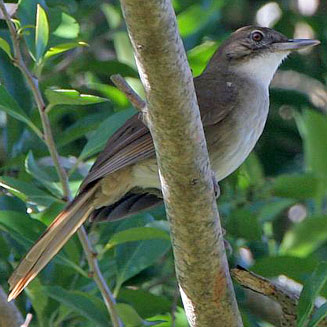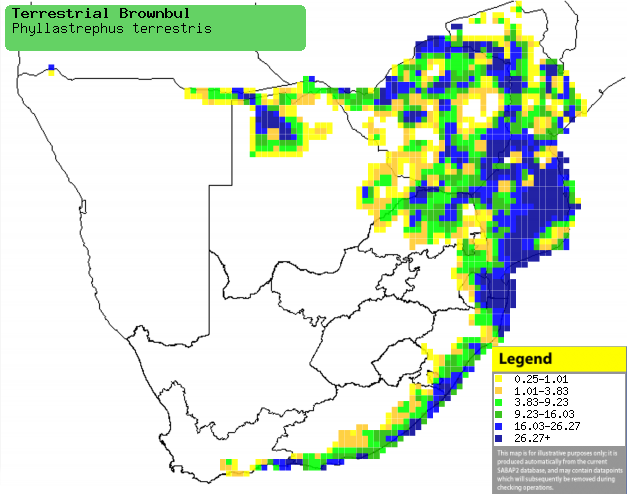|
Phyllastrephus terrestris
(Terrestrial brownbul, Terrestrial bulbul)
Boskrapper [Afrikaans]; Ikhalakandla, Ugwegwegwe, Umnqu
[Xhosa]; Kaapse loofbuulbuul [Dutch]; Bulbul jaboteur [French];
Laubbülbül [German]; Tuta-da-terra [Portuguese]
Life
> Eukaryotes >
Opisthokonta
> Metazoa (animals) >
Bilateria >
Deuterostomia > Chordata >
Craniata > Vertebrata (vertebrates) > Gnathostomata (jawed
vertebrates) > Teleostomi (teleost fish) > Osteichthyes (bony fish) > Class:
Sarcopterygii (lobe-finned
fish) > Stegocephalia (terrestrial
vertebrates) > Tetrapoda
(four-legged vertebrates) > Reptiliomorpha > Amniota >
Reptilia (reptiles) >
Romeriida > Diapsida > Archosauromorpha > Archosauria >
Dinosauria
(dinosaurs) > Saurischia > Theropoda (bipedal predatory dinosaurs) >
Coelurosauria > Maniraptora > Aves
(birds) > Order: Passeriformes
> Family: Pycnonotidae
 |
|
|
Terrestrial brownbul, Wilderness National Park,
South Africa. [photo Trevor Hardaker ©] |
|
Distribution and habitat
Occurs along the far eastern coast of Somalia, Kenya and
Tanzania, Zambia to southern Africa. Here it is common across Zimbabwe,
Mozambique, Caprivi Strip, northern and south eastern Botswana, Lesotho, Limpopo
Province, Mpumalanga and the eastern coast of South Africa (from KwaZulu-Natal
to the Western Cape). It is very inconspicuous and camouflaged, occupying the
shadowy undergrowth of thickly vegetated habitats, such as evergreen and
riparian forest.
|
 |
|
Distribution of Terrestrial brownbul in southern
Africa, based on statistical smoothing of the records from first SA Bird
Atlas Project (©
Animal Demography unit, University of
Cape Town; smoothing by Birgit Erni and Francesca Little). Colours range
from dark blue (most common) through to yellow (least common).
See here for the latest distribution
from the SABAP2. |
Brood parasites
It has been recorded as host of the
Jacobin cuckoo.
Food
It mainly eats arthropods, probing and overturning leaf
litter in search of prey. It also joins mixed-species foraging flocks, and may
occasionally feed on Aloe nectar. The following food items have been recorded
in its diet:
- Insects
- Snails
- Lizards
- Plants
Breeding
- Both sexes build the nest, which is a fragile and untidy cup of twigs,
roots, leaves, moss, bark and lichen, lined with softer plant material. It
is typically placed inconspicuously on a branch near the edge of a bush or
thicket.
- Egg-laying season is from October-April, peaking from November-December.
- It lays 2-3 eggs, which are incubated for roughly 13 days, by both
sexes.
- The chicks are cared for by both parents, becoming independent a few
days after fledging.
Threats
Not threatened.
References
-
Hockey PAR, Dean WRJ and Ryan PG 2005. Roberts
- Birds of southern Africa, VIIth ed. The Trustees of the John Voelcker
Bird Book Fund, Cape Town.
|
